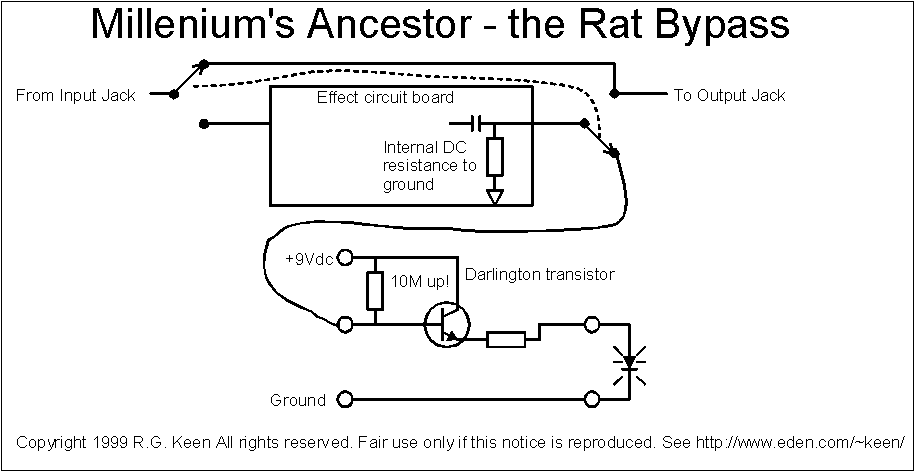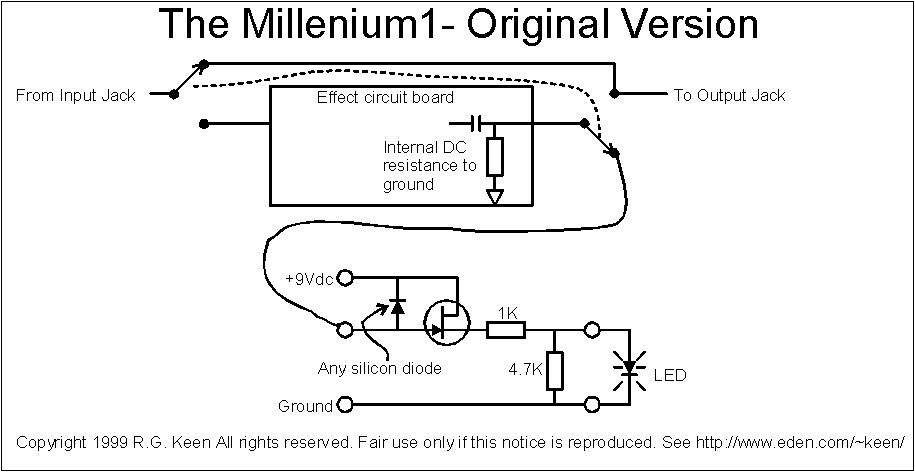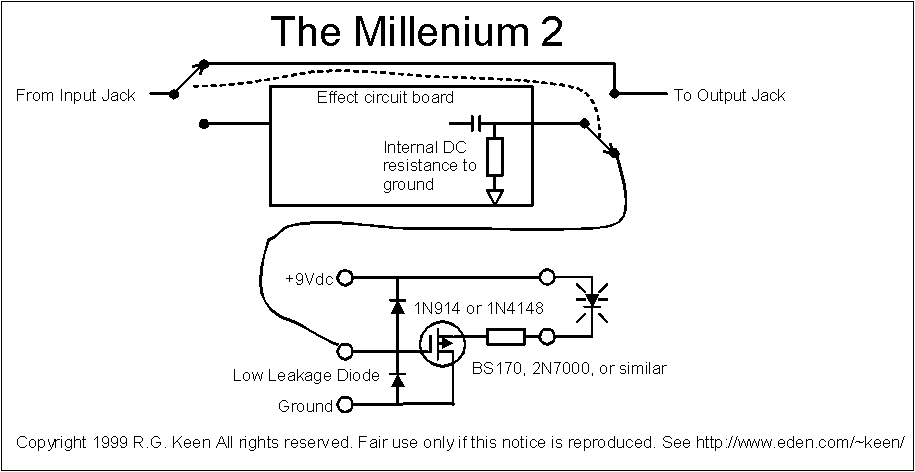The Millenium Bypass - True Bypass and LED indicator with only
a DPDT
Copyright 1998-2004 R.G. Keen. All rights
reserved. Fair use only with this notice.
2004 Update.
I must get four or five questions a
month from beginners who want to build the Millenium and will not read the
whole article. Do not use any old diode as a “low leakage diode”. Use the
collector-base junction of an ordinary small signal NPN transistor. This
junction is intended by design to be low leakage in all modern transistors. A
good example is 2N3904, 2N4124, 2N4401, 2N5088, etc. If you can’t get 2N
transistors, use what you can find. Any BCxxx series NPN will work, as will any
2SCxxxx series small signal device. Get yourself the easiest to find NPN small signal device (TO-92 package is
ideal), cut off the emitter lead at the plastic, and use the resulting C-B
junction for your low leakage diode.
Like most people who have built their own effects, I've wrestled with bypass switches a lot.
As I mention in the Bypass Technical Article, the history of bypasses was to first have minimal bypass, then true bypass, then non-true bypass with a status indicator. The world stuck there, using a double pole double through (DPDT) having to choose either true bypass or a status indicator, but not both at the same time. The only way around that was to use an even more expensive mechanical switch, a triple pole double throw switch.
The whole reason behind true bypass is to keep connections to the effect from loading down the relatively weak guitar signal. Such loading usually removes a lot more treble than bass, and so the loaded sound is dull and lifeless. I tried to get around that by using a JFET switch to open up the connection between the signal line and the effect when the effect is bypassed. Although the effect is still technically connected, the JFET resistance is so high that the effect simply can not load the signal. I called this the "Clinton Bypass" in honor of our former President's examples in the area of truth, as I noted that it was an almost-true bypass and I didn't think anyone could tell it from a real true bypass.
What's wrong with what we had?
In discussing this, I had brought to my attention a variation of bypass used on later Rat distortion pedals. This pedal connected the output of the effect to an indicator control circuit when the effect was bypassed, and the DC resistance of the effect output to ground. The indicator control circuit was an NPN darlington transistor that turned on an LED indicator when the effect output was NOT connected to it. This circuit worked well enough, within its limitations.

The chief limitation is that the output of the effect must have a DC resistance to ground of less than 10K ohms or so, as used in the Rat. That limit is determined because the internal DC resistance to ground at the output of the effect must be able to pull the input of the indicator circuit to very nearly ground. Assuming that the darlington transistor neither sinks or sources current when its base is pulled near ground, the 10M pullup resistor in the indicator circuit and the internal DC resistance of the effect form a voltage divider circuit. The voltage at their junction is easily shown to be 9V*(Rint/(Rint+Rpullup)), and this voltage charges the output capacitor of the effect. When the effect is switched back in, the voltage on the capacitor is connected to the output jack, and appears as a pop in the signal chain. For this circuit to be "pop free" the voltage must be negligible compared to guitar signal. The maximum you can allow is something like 10millivolts. For practical resistors in the 10M range, the output of the effect can be no more than 10K. This is a severe limit.
In the Rat's case, the output resistance is indeed 10K, and the pullup is 10M, so the voltage that the effect output capacitor charges to is 9mv, ignoring any leakages. The output level of a guitar is about 100mv, so this click is 20db down from the guitar's signal. When the effect is un-bypassed, this capacitor voltage is passed on to the next effect or amplifier in the chain.
If you're unlucky enough to have made that next effect a high gain pedal or amp input, the click gets nasty indeed.
The obvious solution, going to ever-higher resistances, has some problems. First, resistors higher than 10M are not that easy to find. 22M is the largest commonly available value, and that means that you will have to limit the output resistance of the effect to 20K or so to keep the click down to a tolerable level with even this high a resistor.
The output resistance having to be so low limits which effects can use this style of bypass, as some vintage effects cannot drive resistances below about 100K with no tonal degradation, so they can't be used with this bypass technique.
I felt like this circuit could be improved, but I didn't want to just copy the darlington-with-resistor pullup approach that the Ratt used, maybe with some diddling values to tune it a bit. I felt like there was a way to make a quantum-step improvement, not limited by the inherent problems that a resistor pullup required for a darlington transistor.
And then the Millenium arrived!
The Millenium 1 Bypass was designed to remove this limit. The Millenium 1 uses an N-channel JFET to drive the indicator circuit instead of an NPN darlington transistor. A JFET has an input current which is almost unmeasurably small, low nano-amperes down to pico-amperes. This is much smaller than the micro amperes an NPN darlington needs.
At first I used a JFET connected as a open-gate source follower. I reasoned that the JFET would be off as a result of opening the gate lead, as internal leakages would make the gate float to the source level, and supply a current equal to Idss to an LED in its source lead. This approach did work... kind of.
My first efforts were very frustrating - with no pullup on the gate of the JFET, the thing would oscillate or latch up and refuse to switch at all sometimes. A lesser experimenter would have given up right there and concluded that JFETs were not suitable for this use.
I decided that the gate had to be pulled up to the supply voltage, not open. A resistor pullup made it work very reliably indeed, but that put me back at the limitations of the darlington transistor. I needed a nano-ampere current source, not a resistor. It hit me as I was staring at the setup on the bench - the leakage current of silicon diodes is small, nanoamperes, and essentially constant over a large range of reverse voltages.

That did it! This approach also cured forever the tendency of the early models to latch up or oscillate. The leakage current of a reverse biased silicon junction as a pullup is plenty to pull up the JFET gate and turn on the LED. Such a small pullup current means that the DC output resistance of the effect pedal can be large and still pull down the input to the indicator circuit. For a 10nA leakage, the resistor to keep the effect capacitor voltage below 10mv is somewhere well over 1 megohm, which is a negligible load for all effects. As such, the Millenium 1 can be used universally.
The Millenium 1 is fascinating to watch - the LED fades in over about 1/2 second. I realized that I was watching the diode leakage current charging the parasitic capacitances of the JFET gate and the wires connecting to it. While the JFET itself should limit the current to the LED, I decided that there ought to be a provision for a series resistor, just in case. There was a very dim glow about the LED even in the "off" state, so I also added a resistor in parallel with the LED to suck any leakage current to ground. This effectively prevented the dim glow in the off state.
In recent experiments, I have found that some silicon diodes are extremely low leakage, in the picoamps, and that these will make the LED turn on even s-l-o-w-e-r. To combat that, simply use a type number 1N914 or 1N4148 diode. These are gold-doped signal diodes; the gold doping speeds them up, but also increases leakage. They are cheap, readily available and all have leakages in the 10 to 15 nA range, ideal for the Millenium 1.
The Millenium 1 also has its limitations, as everything does. The LED does come on slowly, over about 1/2 second. Also, some JFETs have large Vgs threshold voltages, so it takes a lot of voltage to turn them on. These devices willl have a hard time sourcing enough current to the LED. Suitable devices are the 2N5484, 2N5485, .....
The next Millenium
To cure the limitations of the Millenium 1, I came up with the Millenium 2. This version uses a MOSFET transistor, and two diodes at the input. The MOSFET has an even higher input impedance than a JFET. It's so high that it is turned on by the difference in leakage current between two diodes. The pullup diode is still a gold doped 1N914 or 1N4148, and the Mill 2 works just fine with just the one diode. I worried about protecting the gate/source against static electricity and transients. To be doubly sure that static electricity and transients don't exceed the gate-source voltage limit, the second diode acts as a clamp to ground for negative transients. The diode from ground needs to be a low leakage type so that the leakage of the pull up diode is greater and will pull the gate of the MOSFET high. While silicon power diodes work just fine for this, the cheapest low leakage diode is the collector-base junction of an ordinary NPN silicon transistor. These junctions are designed specifically for low leakage as a side effect of their transistor role, and work just fine in this application. The emitter is simply left open. An even-lower leakage junction can be found in the gate-source junction of a JFET transistor, although this does not not perform any better in this application than the NPN transistor base and costs a bit more.

The Millenium 2 circuit is an inverter, not a follower like the Millenium 1, so the LED must be in the drain circuit of the device, and there must be a current limiting resistor in series with it. It's worth noting that a darlington transistor will also work in this circuit, except that it must use a resistor to pull it up, and will again suffer from clicks.
The links below show the Millenium 1 and 2 Bypass circuits, both in N-channel version for normal negative-ground battery effects, and P-channel version for things like the older germanium powered stuff with a positive power supply ground. I've included the schematic for the Rat bypass just for completeness.
OK, go build one!
The circuit board links show you how to make and mount your own Millenium board. For this one, don't get fancy - just clean some copper clad, and trace or draw in the pattern on the top, then etch. I have included two layouts, one for "D-S-G" pinout JFETs and one for "D-G-S" JFETs like the 2N3819 and also for "C-B-E" darlingtons if you feel the need to use that one. There is also a place for a resistor in series with the LED; this is optional for the JFET versions, but mandatory for the darlington one.
Mount the components on the copper side by forming the leads to fit to the surface and soldering them right to the copper as shown. The board is designed to mount one of three ways, depending on how you connect up the LED. You can put the LED through holes you drill for it, but it's as simple to merely bend the LED leads to solder it to the copper. Mount the LED and board with double-sided foam tape or hot glue to the inside of your circuit board. This is where the single-sided board, with no conductors on the back really pays off.
For positive ground effects, like the old Fuzz Face, you have to change to a P-channel JFET and reverse the diode and LED polarities.